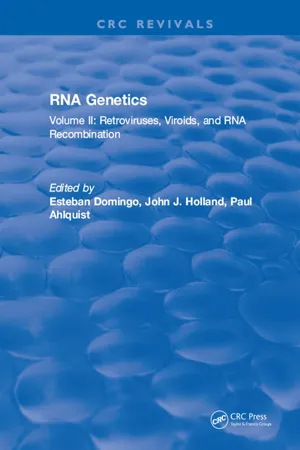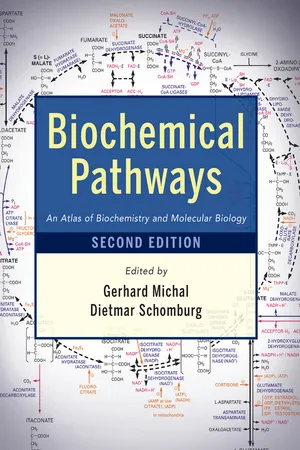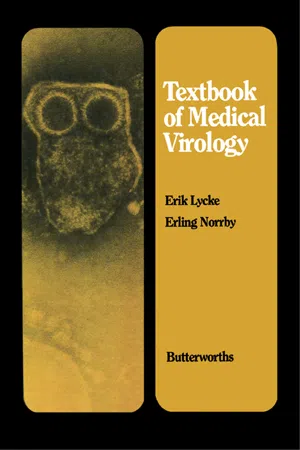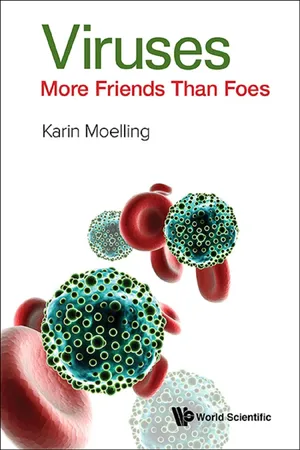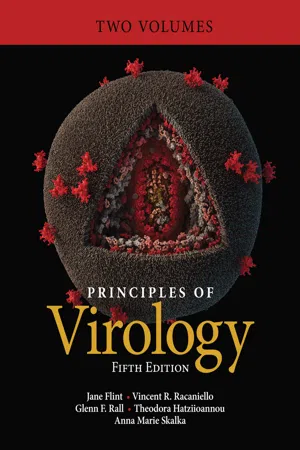Biological Sciences
Retroviruses
Retroviruses are a type of RNA virus that can integrate their genetic material into the DNA of the host cell. They are known for their ability to cause diseases such as HIV/AIDS and certain types of cancer. Retroviruses have a unique enzyme called reverse transcriptase, which allows them to convert their RNA into DNA once inside a host cell.
Written by Perlego with AI-assistance
Related key terms
Related key terms
1 of 4
Related key terms
1 of 3
8 Key excerpts on "Retroviruses"
- eBook - ePub
Viruses
From Understanding to Investigation
- Susan Payne(Author)
- 2017(Publication Date)
- Academic Press(Publisher)
Chapter 36 Family Retroviridae Abstract Retroviruses are enveloped viruses with RNA genomes. They are one of two families of animal viruses that reverse transcribe their genomes. Reverse transcription is the term used to describe the synthesis of a DNA copy of an RNA molecule. Reverse transcriptase (RT) is the polymerase that catalyzes the process (RT is an RNA-dependent DNA polymerase). An older name for the group of viruses we now call Retroviruses was “RNA tumor virus” because many are associated with transmissible cancers in mammals and birds. Retroviruses can transform cells because they must insert or integrate their genomes into the host cell chromosome, an activity that is inherently mutagenic. But Retroviruses are much more than just cancer agents. About 8% of the human genome is comprised of retroviral sequences; Retroviruses have shaped our genomes and driven our evolution. The human immunodeficiency virus (HIV), discovered only a few decades ago, infects millions of people worldwide. It causes disease primarily by damaging of a subset of T-lymphocytes that are central regulators of the immune response - eBook - ePub
RNA Genetics
Volume II: Retroviruses, Viroids, and RNA Recombination
- Esteban Domingo(Author)
- 2018(Publication Date)
- CRC Press(Publisher)
Reverse Transcribing Viruses and RetrotransposonsPassage contains an image Chapter 1 REPLICATION OF RETROVIRUS GENOMES John M. Coffin TABLE OF CONTENTS
I. INTRODUCTIONI. Introduction II. Overview and Statement of the Problem III. The Virion IV. The Genome V. Replication A. Initial Events B. Integration C. Expression D. RNA Processing E. Protein Synthesis and Processing F. Transactivation VI. Consequences of Retrovirus Replication A. Transformation and Oncogenes B. Cytopathic Interactions VII. Evolution and Genetics References The study of Retroviruses has proven to be a remarkably fruitful endeavor. Although regarded for many years as curiosities of little direct relevance, no one would presently dispute the importance of these agents to modern biology. Retroviruses are now universally recognized as important human and animal pathogens, as valuable models for carcinogenesis, and as paradigms for a mechanism of information transfer that has apparently been a strong force in modeling eukaryotic genomes. There is little reason to doubt that continued study of the basic molecular biology of these fascinating viruses will continue to yield large dividends in our understanding of fundamental processes of practical importance and intellectual appeal.At first glance, retrovirus replication seems dauntingly complex, replete with jumps and other contortions involving a variety of enzymatic activities and unusual DNA and RNA structures. In this brief chapter, it is my intention to try to convince the reader that much of the complex phenomenology of these viruses follows in a straightforward way from a few basic principles, and that once these principles are understood, one can (with only a little guidance from prior knowledge) reconstruct much of the life cycle and genetics of the viruses.Retroviruses are unique among vertebrate viruses in many respects. Of all viruses, they have the most intimate association with the host cell, using systems preexisting within the normal cell to accomplish all but the initial steps of the replication cycle, inserting their genetic information into the cell genome to form an irreversible lifetime association — one in which by far the most common outcome is that the cell becomes a producer of new virions, but is otherwise not significantly altered in its physiology. Indeed, alone among eukaryotic viruses, retrovirus infection can span generations, being passed on as endogenous proviruses following infection of the germline. The exceptions to this general rule, although dramatic, are rare. Human immunodeficiency virus (HIV) and the related lentiviruses cause disease as a consequence of the killing of specific target cells, yet the viruses can persist and replicate in the infected individuals for years without significant pathogenic effect. Another exception is found in the prototypic retrovirus isolates — the oncogene-containing viruses — which readily induce malignant transformation in appropriate infected target cells. Although the transforming viruses were the first and most intensively studied members of the family, and have been crucial to understanding the molecular basis of cancer, they are in fact the consequence of uncommon aberrations in the virus replication cycle. They thus represent evanescent phenomena which, if not provided with a good home in the laboratory, do not survive for long in nature. - eBook - ePub
Biochemical Pathways
An Atlas of Biochemistry and Molecular Biology
- Gerhard Michal, Dietmar Schomburg, Gerhard Michal, Dietmar Schomburg(Authors)
- 2013(Publication Date)
- Wiley(Publisher)
The DNA intermediate is then incorporated into the host genome by a virus-encoded integrase enzyme. Retroviruses are major pathogens affecting nearly all vertebrates. As an example, the intensively investigated human immunodeficiency virus (HIV-1) is described here. This virus is the causative agent of the acquired immunodeficiency syndrome (AIDS). The mode of retrovirus replication with an obligatory viral genome integration into the host genome is inherently mutagenic. Insertion of a retrovirus at a certain region in the host genome may activate previously silent proto-oncogenes or disrupt tumor suppressor genes. Retroviruses are therefore commonly associated with cell transformation. In addition, through the process of host genome integration and recombination, Retroviruses can acquire full or truncated host genes. A number of Retroviruses became acute transforming viruses, because they carry oncogenes that have the ability to transform normal cells into tumor cells. The best known example is Rous Sarcoma Virus, which carries a transforming version of the c-src gene. A number of other oncogenes have been observed in acute transforming Retroviruses, including growth factors (v-Sis), growth factor receptors (v-erbB), kinases (v-src, v-abl) or transcription factors (v-myc). See Table 7.5-5. 5.4.1 Human Immunodeficiency Virus (HIV) Genome structure of HIV-1 and protein processing (Fig. 5.4-1): The 9.7 kb dimeric (+)RNA genome of HIV-1 contains gag-pol-env genes coding for the essential enzymes and structural protein precursors (common to all Retroviruses) and additionally, a number of regulatory genes. This RNA sequence is flanked by 3′ and 5′ enhancer and promoter sequences as well as untranslated (U3, U5) and repetitive (R) sequences, which are of importance in the reverse transcription step - eBook - ePub
- Erik Lycke, Erling Norrby(Authors)
- 2014(Publication Date)
- Butterworth-Heinemann(Publisher)
primary transcription ). It has been shown that these mRNAs have poly (A) at the 3′ end and a ‘cap’ in their 5′ end. It appears that a certain transcription from cellular DNA is necessary for the syrthesis of a functional virus-mRNA and it has recently been demonstrated that host cell mRNAs serve as initiators for virus transcription. Virus-mRNAs are bound to ribosomes and new virus proteins are formed. Shortly thereafter another kind of plus-strand RNA with a length equal to that of minus-strand virion-RNA can be identified. This complementary RNA serves as template for the replication of virion-RNA. Complementary RNA molecules have to be present in equimolar amounts for each RNA segment. In contrast, it can be shown that the amount of mRNA from different segments varies. The occurrence of mRNA correlates well with its capacity to form the individual virus proteins. Thus it appears that the synthesis of viral proteins is controlled by transcription of mRNA from different segments.Retroviruses
Retroviruses have properties which are characteristic of both RNA and DNA viruses. Virions contain RNA, but their intracellular form is a DNA which is integrated into cellular DNA. After the virus nucleoprotein has been introduced into the cytoplasm of cells, the virion-associated polymerase converts virion-RNA into DNA which then can be integrated among cellular genes. As a consequence, virus-DNA can be transferred from one generation of cells to the other in the form of a stable, integrated molecule of DNA. In contrast to other cytolytic RNA viruses, the Retroviruses have a capacity to maintain a productive infection for a long time without killing cells. The central and most important property of Retroviruses thus is their capacity to convert RNA into DNA, a process which has been defined as reverse transcription. Retroviruses represent the only known example of information flow in the opposite direction to that which is seen in normal cells.All retrovirus genomes contain between 5000 and 9000 nucleotides and each virion contains two identical RNA molecules which are coupled at their 5′ ends. The RNA is combined with four capsid proteins that are derived by cleavage from the polyprotein gag (group a ntigen). The capsid also contains a reverse transcriptase, pol (poly merase) and the envelope of the virus contains one glycoprotein, env (env elope).One retrovirus which has been studied extensively is avian sarcomavirus (ASV). The ASV genome contains four genes with the following sequence from the 5′ end of RNA (Figure 8.8a ): gag, pol, env and src (sarcoma). The src gene is responsible for transformation of the host cell (see Chapters 11 and 18 - eBook - ePub
- David P. Clark(Author)
- 2009(Publication Date)
- Academic Cell(Publisher)
Fig. 17.24 ).The retrovirus DNA is then inserted into the host cell DNA. Once integrated, the retrovirus DNA is never excised but remains permanently inserted in the host genome. Consequently, retro-viruses are impossible to get rid of completely after infection and integration, at least using current medications and procedures.Figure 17.24 Reverse TranscriptaseDuring normal transcription, mRNA is made using the template strand of DNA (left). Retroviruses convert their ssRNA to a double-stranded DNA molecule using an enzyme called reverse transcriptase. Making double-stranded DNA from ssRNA is a two step process. First a complementary strand of DNA is made forming an RNA-DNA hybrid molecule. The original RNA is then degraded and a second DNA strand is made.AIDS (aquired immunodeficiency syndrome) Disease caused by human immunodeficiency virus (HIV) that damages the immune system Retroviruses A family of animal viruses with single-stranded RNA inside two protein shells surrounded by an outer envelope. They possess reverse transcriptase which is used to convert the ssRNA version of the genome to a dsDNA copy reverse transcriptase An enzyme that uses single-stranded RNA as a template for making double-stranded DNA Retrovirus particles carry ssRNA of the plus conformation. Although this RNA has a sequence identical to a messenger RNA, it is not used as an mRNA. Instead it is used as a template for reverse transcriptase to make a DNA copy of the retrovirus genome (Fig. 17.24 ). Reverse transcriptase first uses ssRNA to make a complementary DNA strand. It then degrades the RNA and uses the first DNA strand as a template to make a second DNA strand. The process of making a double-stranded DNA copy from an RNA sequence is known as reverse transcription - eBook - ePub
- Karin Moelling(Author)
- 2016(Publication Date)
- WSPC(Publisher)
Now that, figuratively speaking, every possible genome has been sequenced, the latest surprise has been that there are numerous reverse transcriptases around. They are present in many organisms, in all eukaryotes (animals and plants), and also in archaea, in bacteria, in spliceosomes, in retrotransposons, in a strange chimeric multi-satellite msDNA, and in human and bacterial immune systems. In bacteria alone there are more than 1000 different kinds of reverse transcriptases. What are they all there for? In mammalian cells we know about the retrotransposons, which code for reverse transcriptases necessary for the “copy-and-paste” mechanism of cellular DNA described below (retrotransposons are reminiscent of simplified Retroviruses). How unexpected this was can be described by an anecdote. In 1978 one of the co-discoverers of the reverse transcriptase David Baltimore got up in a meeting when someone described the existence of the reverse transcriptase in flies: “To my knowledge flies do not have Retroviruses.” Only much later now we know the answer — also flies have reverse transcriptases not from Retroviruses but from their relatives, the retrotransposons, which are precursors or truncated “crippled” Retroviruses and widely distributed including flies, they are extremely abundant. The Retroviruses as special case happened to be discovered first!Thus, we find reverse transcriptases not only linked to Retroviruses. Since phages are also viruses mainly containing DNA, one could imagine that they also once had RNA and only later DNA genomes and in between retrovirus-like properties, just by evolution. Then one would expect to find “retrophages” too. I made this word up. But, to my knowledge, only a single “retrophage” harboring a reverse transcriptase exists — in spite of an intense search that I also joined in with (see below).We now know that the reverse transcriptase is a key enzyme in biology. Perhaps it even “invented” the DNA in the first place; the RT enzyme was certainly essential in building up genomes, including our own, during evolution, where it is recognizable more than 100 million years back. Perhaps there initially existed a simpler, more primitive, precursor RT. I stress the importance of the reverse transcriptase not (only) because as a specialist for this enzyme my view is biased — but there is even novel evidence for its outrageous importance: it is one of the most abundant proteins worldwide and even the top one in an ocean sampling project, being 13.5 percent of all proteins there in the plankton — 45 years later. How come? Retroviruses, retrotransposons, copy-and-paste mechanisms belong together and built the genomes in biological systems as drivers of evolution. The RT is the top number one molecule — together with the RNase H following in the next chapter. - eBook - ePub
Scott-Brown's Otorhinolaryngology and Head and Neck Surgery
Volume 1: Basic Sciences, Endocrine Surgery, Rhinology
- John Watkinson, Ray Clarke, John C Watkinson, Ray W Clarke(Authors)
- 2018(Publication Date)
- CRC Press(Publisher)
Epstein-Barr virus (EBV) is also called human herpes virus 4 (HHV4), and is the cause of infectious mononucleosis or ‘glandular fever’. It is transmitted through contact with saliva. Viral entry into cells occurs through binding to CD21 (entry into B cells) and β1 integrin (entry into epithelial cells). Similarly to HSV, after the primary infection, the infection enters a chronic latent phase that at the moment cannot be cured. As further detailed below, EBV is associated with several malignancies.Retroviruses
One large class of single-stranded RNA viruses are the Retroviridae, or Retroviruses, which contain the enzyme reverse transcriptase, allowing them to synthesize double-stranded DNA from their RNA genome. One such virus is the human immunodeficiency virus (HIV), which is discussed in Chapter 23 .Rubivirus
Rubella, also known as German measles, is a positive sense ssRNA virus with a lipoprotein envelope. Viral replication occurs in cells of the respiratory system. It is a purely human virus, with no animal reservoir, so could theoretically be eliminated with global vaccination strategies. In developed countries, vaccination has reduced the incidence of rubella to non-endemic levels. If contracted during pregnancy, rubella can cause congenital rubella syndrome in the foetus, with profound and serious consequences including ocular and neurological abnormalities and deafness.8Human papilloma virus
Human papilloma virus (HPV) is a family of DNA viruses. There are at least 70 subtypes of HPV so far identified. Many of these are thought to be asymptomatic; however, a subset of HPV subtypes is associated with human disease (Table 20.1).Table 20.1 Conditions associated with particular HPV typesConditions with a viral aetiology
Viruses are responsible for a wide range of pathologies involving the head and neck (seeTable 20.2for a non-exhaustive list), and some of the most common ones are briefly described below.Table 20.2 Pathologies and associated virusesLaryngeal papillomatosis
HPV6, 11 and more rarely HPV 16 are specifically associated with laryngeal papillomas. Treatment requires repeated laryngoscopy and bronchoscopy to facilitate surgical ablation of forming papillomas and avoid airway obstruction. Although malignant transformation can occur it is rare and typically associated with patients with additional risk factors such as smoking or long-term illness. - eBook - ePub
- Jane Flint, Vincent R. Racaniello, Glenn F. Rall, Theodora Hatziioannou, Anna Marie Skalka(Authors)
- 2020(Publication Date)
- ASM Press(Publisher)
Table 7.2 ). Although specific inhibition of RNA polymerase I can impair reproduction of some DNA viruses, such as the herpesvirus human cytomegalovirus, there is as yet no evidence that this enzyme transcribes viral templates.Some Viral Genomes Must Be Converted to Templates Suitable for Transcription
Viral DNA molecules that are transcribed by cellular RNA polymerases must enter the infected cell nucleus, but there is considerable variation in the reactions needed to produce templates that can be recognized by the cellular machinery. Some viral genomes are double-stranded DNA molecules that can be transcribed as soon as they reach the nucleus. Transcription of specific genes is therefore the first biosynthetic reaction in cells infected by adenoviruses, herpesviruses, papillomaviruses, and polyomaviruses. Other viral DNA genomes must be converted from the form in which they enter the cell to double-stranded molecules that serve as transcriptional templates (Fig. 7.1 ). Viral DNA genomes that are partially or largely single-stranded, such as those of hepadnaviruses and parvoviruses, respectively, are converted to fully double-stranded DNA molecules by cellular enzymes. The prerequisites for expression of retroviral genetic information are more demanding, for the (+) strand RNA genome must be both converted into viral DNA and integrated into the cellular genome. Reverse transcription creates an appropriate double-stranded DNA template that includes the signals needed for its recognition by components of the cellular transcriptional machinery (Chapter 10 ).(A) Hepadnaviral templates for transcription are closed, circular, double-stranded DNA molecules. Such DNA is formed by repair of the partially double-stranded, gapped DNA genomes by cellular DNA repair and synthesis enzymes. (B) The single-stranded DNA genomes of parvoviruses such as adenovirus-associated virus carry an inverted terminal repetition with a free 3′ OH end. Copying of the viral genome from this primer by cellular DNA polymerase (Chapter 9 ) produces a double-stranded template for transcription. (C) Viral enzymes catalyze the conversion of retroviral (+) RNA genomes to double-stranded DNA and its subsequent integration into the host cell genome (proviral DNA) (Chapter 10Figure 7.1Conversion of viral genomes to templates for transcription by cellular RNA polymerase.
Index pages curate the most relevant extracts from our library of academic textbooks. They’ve been created using an in-house natural language model (NLM), each adding context and meaning to key research topics.
Explore more topic indexes
Explore more topic indexes
1 of 6
Explore more topic indexes
1 of 4

